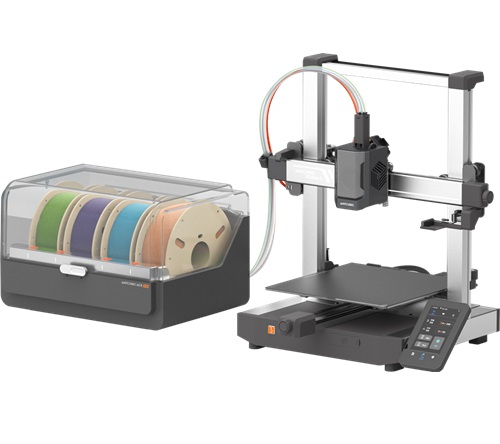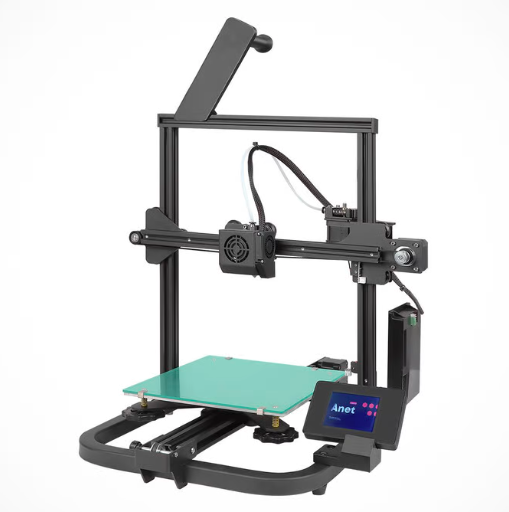Compare Kobra 3 Combo vs A8 V2
Comparison between the best 3D printers
Choose the best 3D printer at the best price. The cheapest 3D printers are here.
Buy a 3D printer here with 3D Fila.
 |
 |
|
| Model | Kobra 3 Combo[BUY Kobra 3 Combo] |
A8 V2 |
| Printing Material | Filament | Filament |
| Buy Filament for Anycubic Kobra 3 Combo | Buy Filament forAnet A8 V2 | |
| Estimated price | $349,00 | $129,00 |
| Manufacturer | Anycubic | Anet |
| Release Year | 2024 | 2021 |
| Print Volume [mm] | 250x250x260 | 220x220x250 |
| Printer Size [mm] | 452x504x483 | 428x441x486 |
| Weight [kg] | 9,2 | 6,2 |
| Power Loss Recovery | YES | NO |
| Enclosed printer | NO | NO |
| Bed Leveling | Automatic | Manual |
| Filament End Sensor | YES | NO |
| Bed type | Heated | |
| Power supply system | Direct Drive | Bowden |
| Standard nozzle | 0,4 | 0,4 |
| Maximum Nozzle Temperature [°C] | 300 | 230 |
| Maximum Bed Temperature [°C] | 110 | |
| Maximum printing speed [mm/s] | 600 | 150 |
| Filament holder | YES | YES |
| Camera for supervision | NO | NO |
| Recommended filaments | PLA, PETG, ABS, PP, HIPS | PLA |
| Recommended slicers | Anycubic Slicer, Cura, Orca Slicer | Cura, Simplify, Slic3r, IdeaMaker |
| Maximum Resolution [mm] | 0,1 | 0,1 |
| Processor | 32 bits | |
| Display | Touchscreen 4,3'' | Display touchscreen 2,8'' |
| Power Supply | 400 W | 110/220V / 250W |
| Connectivity | USB, Wi-Fi, Cloud | SD / USB |
| Operating systems | Windows, Linux, Macbook | Windows, Mac, Linux |
| Date of registration in the system | 2024-06-27 | 2022-11-10 |
| Release date | 2024 | 2021 |
| Extra features | The Anycubic Kobra 3 Combo offers advanced features, including multi-filament printing with the ACE (Anycubic Color Engine) system, allowing for quick switching of up to four filaments. It features automatic bed leveling, nozzle clogging detection, and integrated filament drying during printing. The printer supports technical materials such as ABS, ASA, Nylon, and PC, thanks to the hotend that reaches 300°C and the heated bed up to 110°C. In addition, it has a 4.3-inch touchscreen and compatibility with various slicers such as Anycubic Slicer, Cura, and Orca Slicer. | The Anet A8 V2 is a Cartesian-XZ type 3D printer with a build volume of 220 x 220 x 250 mm, Ender 3 design and V-slot assembly. It has a 32-bit motherboard and touchscreen interface, promising ease of use. It uses open source firmware and has thermal failure protection. It stands out for its cable organization and the absence of a heated bed, focusing on energy savings and PLA printing. It comes with an external power adapter, aiming at greater safety, especially for beginners and educational use. |
| Support for multiple colors and materials (AMS and CFS) | YES | NO |
Notes * |
||
| Cost-benefit | 8 / 10 | 6 / 10 |
| Hardware | 4.5 / 10 | 0.6 / 10 |
| Tela | . | . |
| Print volume | 4 / 10 | 3 / 10 |
| Performance | 5 / 10 | 1 / 10 |
| [BUY Kobra 3 Combo] |
Conclusion |
| In conclusion, the comparison between the Anycubic Kobra 3 Combo and the Anet A8 V2 highlights key differences that could influence a buyer's decision based on their specific needs and budget. The Anycubic Kobra 3 Combo, with its higher price tag, justifies the cost through a range of advanced features such as automatic bed leveling, power loss recovery, a larger print volume, and compatibility with various filaments and materials. Its ability to support multiple colors and materials, alongside a powerful maximum nozzle temperature, positions it as a versatile option for more experienced users or those seeking to print with a wider range of materials. The inclusion of a touchscreen interface and modern connectivity options further enhance its user experience. On the other hand, the Anet A8 V2 presents a more cost-effective solution tailored for beginners or those primarily focused on printing with PLA. While it lacks several advanced features and has a smaller print volume, its simplicity, lower weight, and energy-efficient design serve well for educational purposes or casual hobbyists. The open-source nature and safety features make it appealing for users who are starting their 3D printing journey. Ultimately, if budget permits and a broader range of capabilities is desired, the Kobra 3 Combo stands out as a more advanced choice. Conversely, for those on a tighter budget or those focused on PLA printing, the A8 V2 may provide sufficient performance without the added complexity. The decision rests on the user's experience level, intended use, and willingness to invest in additional features. |

